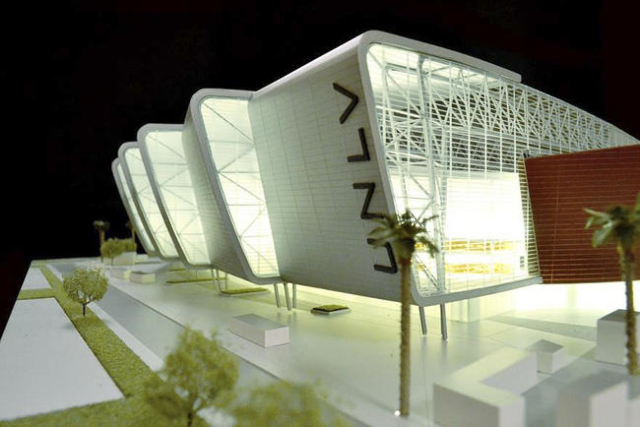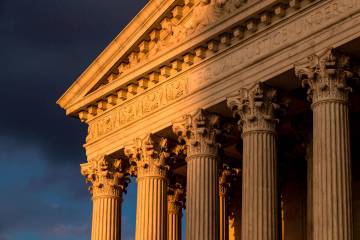EDITORIAL: No place like dome: Stadium proposal a must-do
Las Vegas desperately needs a new stadium. For that to happen, the city desperately needs a plan for a new stadium.
Last week, we got one. And it's the most viable project pitch the region has seen since aging Sam Boyd Stadium was conceived nearly 50 years ago.
As reported by the Review-Journal's Howard Stutz, casino giant Las Vegas Sands Corp. will lead a consortium of investors in funding a $1.2 billion domed stadium on 42 acres near the University of Nevada, Las Vegas, just east of the Strip along Tropicana Avenue. The venue would be the new home of the school's football team, but more importantly, it would allow Las Vegas to attract and grow special events that require a modern, large-capacity events center. Andy Abboud, Las Vegas Sands' senior vice president of government relations and community development, said Las Vegas needs a stadium with at least 65,000 seats to drive additional tourism to Southern Nevada through big concerts and music festivals, soccer, neutral-site college football games and other events.
(Full disclosure: The family of Las Vegas Sands Chairman and CEO Sheldon Adelson bought the Review-Journal in December. Las Vegas Sands or the Adelson family would contribute an undisclosed share of about $420 million in private financing for the stadium.)
Unlike any other market in the United States, Las Vegas won't need a professional sports franchise as an anchor tenant to close the deal. And Las Vegas Sands and its partners are committed to pursuing the project regardless of whether the city ever lands a National Football League or Major League Soccer team.
On Friday, Oakland Raiders owner Mark Davis met with Mr. Adelson, Wynn Resorts Chairman and CEO Steve Wynn and other Las Vegas leaders. The NFL team, which left Oakland in the early 1980s for Los Angeles, only to move back to Oakland in 1994, has made plenty of noise lately about getting into a new stadium, and if that means a new city, too, then so be it. Las Vegas Sands officials said they've had conversations with other NFL franchises as well.
As reported by the Los Angeles Daily News, hours after Mr. Davis visited Las Vegas, the NFL sent a memo to all 32 franchises that said the league has no rules against moving to any particular market, including Las Vegas. The memo directed the teams to not assume that a move to Las Vegas would be vetoed by the league because of its longstanding opposition to sports betting. It said the NFL, which needs 24 yes votes by owners to move a franchise, would take Las Vegas as serious as any other prospective home for relocation. Such a memo would not have been written if the stadium plan appeared half-baked.
Las Vegas will be unique among the cities Mr. Davis considers for the relocation of his team. Everywhere else except Los Angeles — the Raiders could be back in play there after Friday's news that the NFL is upgrading its commitment to keep the Chargers in San Diego — Mr. Davis will have to work out a stadium financing plan that will be contingent upon a Raiders move, with the NFL and the Raiders providing some funding. The Las Vegas project proposes a public-private partnership, with about one-third of the funding from private investors and two-thirds from tax revenues. While the financing details are far from locked down, it's evident that Las Vegas Sands and Los Angeles-based Majestic Realty — whose president, Edward Roski Jr., owns the Silverton — are prepared to pay part of the bill. UNLV should be able to provide a philanthropic component to the plan.
The location is about as good as it gets, on a huge plot of vacant land recently purchased for $50 million by UNLV (via donation), a transaction we previously championed for just this purpose. The proximity to the resort corridor and to UNLV offers countless benefits to both.
As Mr. Abboud stated, "The whole concept of the stadium, everything we have looked at, is under the assumption that there is no NFL team. … This is first and foremost about the community and UNLV and about enhancing visitation."
Indeed. This stadium is the missing piece of tourism infrastructure in Las Vegas, more important than any other proposal, including the expansion of the Las Vegas Convention Center. We have previously endorsed that expansion, but for years, we've also aggressively called for a viable stadium plan. The stadium is the valley's most urgent need to expand the tourism, travel and events dynamic. A large, multipurpose venue would create the most economic impact for Las Vegas right now, more than any new hotel or additional convention space.
Las Vegas Sands estimates the domed stadium would provide $600 million to $800 million in total annual economic benefit, including $200 million in direct construction wages and $300 million annually for Las Vegas resort and retail sectors. That's quite a multiplier.
That might require diversion of hotel room tax revenues that now support the Las Vegas Convention and Visitors Authority, something LVCVA CEO Rossi Ralenkotter is not enthusiastic about, although he's eager to see the stadium proposal. The Las Vegas Sands proposal also includes rental car and taxicab taxes as potential revenue streams. It would be perfectly reasonable to use current room tax funds to complete the project's funding puzzle. If fully funding the stadium requires scaling back the convention center expansion, then lawmakers and local officials should do it. If the Taxicab Authority were abolished, as recommended by a recent state audit, the revenues that support the agency could be diverted to the stadium project. A room tax increase, or any tax increase, should be the last option on the table. But if the deal can be pulled together by early next year, the dome could host its first event in 2020.
Within the next two months, Las Vegas Sands plans to present its idea to the Southern Nevada Tourism Infrastructure Committee. This stadium is an urgent need, and a better offer might never come along. All parties involved should figure out a way to finalize this plan so it's ready for approval on the first day of the 2017 Legislature.

















